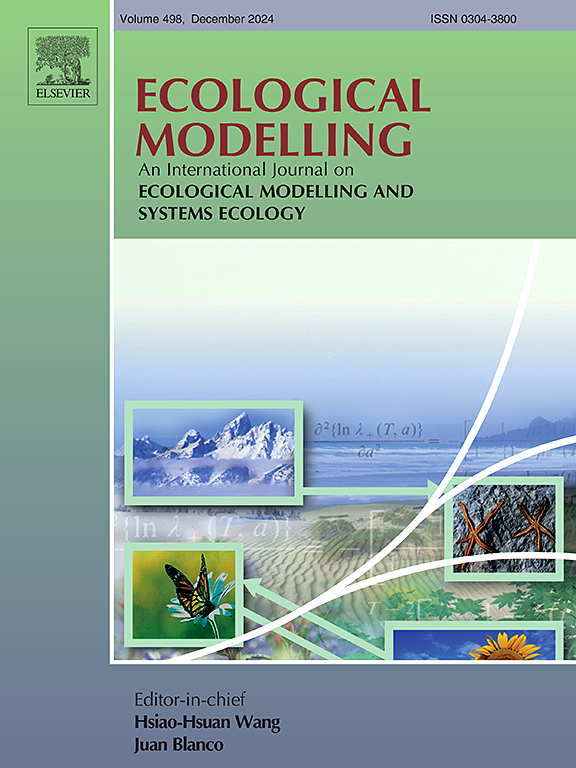Integrating multiple data sources with species distribution models to estimate the distribution and abundance of northern bobwhite (Colinus virginianus) in the United States
IF 3.2
3区 环境科学与生态学
Q2 ECOLOGY
引用次数: 0
Abstract
Species distribution models (SDMs) have traditionally focused on occupancy despite abundance potentially being a more useful metric for informing conservation initiatives. Integrating multiple species abundance datasets could retain the strengths of each data type and, at least partially, offset their weaknesses, potentially improving the performance of abundance-based SDMs. We developed spatially-non-stationary, abundance-based SDMs to assess the environmental drivers of spatial variation in abundance and to predict the abundance and distribution of northern bobwhite (Colinus virginianus) across the United States. We fitted Bayesian SDMs with regionally-partitioned coefficients by integrating structured North American Breeding Bird Survey (BBS) and semi-structured eBird count data. We found that bobwhite abundance was concentrated in three main regions: southern Texas, the Great/Midwestern Plains, and the southeastern coastal plain. Total abundance across the range was estimated at 8,577,291 (8,292,554 - 8,933,202). While the spatial extent of the predicted bobwhite range was generally similar across models, models fit with single data sources appeared to vastly underestimate (eBird) or overestimate (BBS) abundance, though abundance estimation was improved through data integration. Most covariate effects exhibited non-stationarity across the range, potentially leading to inappropriate inferences or management decisions from a spatially-stationary model. Our study provides an important example of how datasets collected at different spatial scales under different observation protocols can be integrated via SDMs to improve abundance-based modeling and correct for weaknesses of individual datasets. Our modeling framework provides regional estimates of the drivers of bobwhite abundance and range-wide estimates of abundance for guiding both local and range-wide bobwhite conservation.
结合多种数据源和物种分布模型估算美国北部山齿鹑(Colinus virginianus)的分布和丰度
物种分布模型(SDMs)传统上关注的是占用率,尽管丰度可能是为保护举措提供信息的更有用的指标。整合多个物种丰度数据集可以保留每种数据类型的优势,至少部分抵消它们的弱点,从而有可能提高基于丰度的sdm的性能。我们开发了空间非平稳的、基于丰度的SDMs来评估丰度空间变化的环境驱动因素,并预测北山齿鹑(Colinus virginianus)在美国的丰度和分布。通过整合结构化的北美繁殖鸟调查(BBS)和半结构化的电子鸟类统计数据,对贝叶斯sdm进行了区域划分系数拟合。我们发现,山齿鹑的丰度主要集中在三个地区:德克萨斯州南部、大平原/中西部平原和东南部沿海平原。整个范围内的总丰度估计为8,577,291(8,292,554 - 8,933,202)。虽然不同模型预测的山齿鹑分布范围的空间范围大致相似,但单一数据源拟合的模型似乎大大低估了(eBird)或高估了(BBS)丰度,尽管通过数据整合改进了丰度估计。大多数协变量效应在整个范围内表现出非平稳性,这可能导致从空间平稳模型中得出不适当的推论或管理决策。我们的研究提供了一个重要的例子,说明如何通过sdm集成不同空间尺度下不同观测方案下收集的数据集,以改进基于丰度的建模并纠正单个数据集的弱点。我们的建模框架提供了山齿鹑丰度驱动因素的区域估计和范围内的丰度估计,以指导当地和范围内的山齿鹑保护。
本文章由计算机程序翻译,如有差异,请以英文原文为准。
求助全文
约1分钟内获得全文
求助全文
来源期刊

Ecological Modelling
环境科学-生态学
CiteScore
5.60
自引率
6.50%
发文量
259
审稿时长
69 days
期刊介绍:
The journal is concerned with the use of mathematical models and systems analysis for the description of ecological processes and for the sustainable management of resources. Human activity and well-being are dependent on and integrated with the functioning of ecosystems and the services they provide. We aim to understand these basic ecosystem functions using mathematical and conceptual modelling, systems analysis, thermodynamics, computer simulations, and ecological theory. This leads to a preference for process-based models embedded in theory with explicit causative agents as opposed to strictly statistical or correlative descriptions. These modelling methods can be applied to a wide spectrum of issues ranging from basic ecology to human ecology to socio-ecological systems. The journal welcomes research articles, short communications, review articles, letters to the editor, book reviews, and other communications. The journal also supports the activities of the [International Society of Ecological Modelling (ISEM)](http://www.isemna.org/).
 求助内容:
求助内容: 应助结果提醒方式:
应助结果提醒方式:


